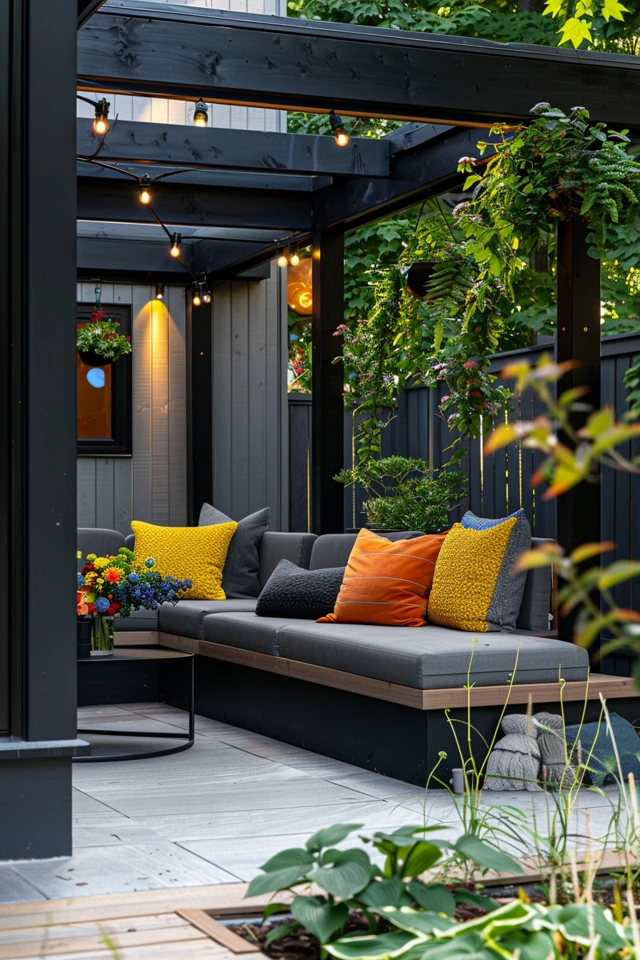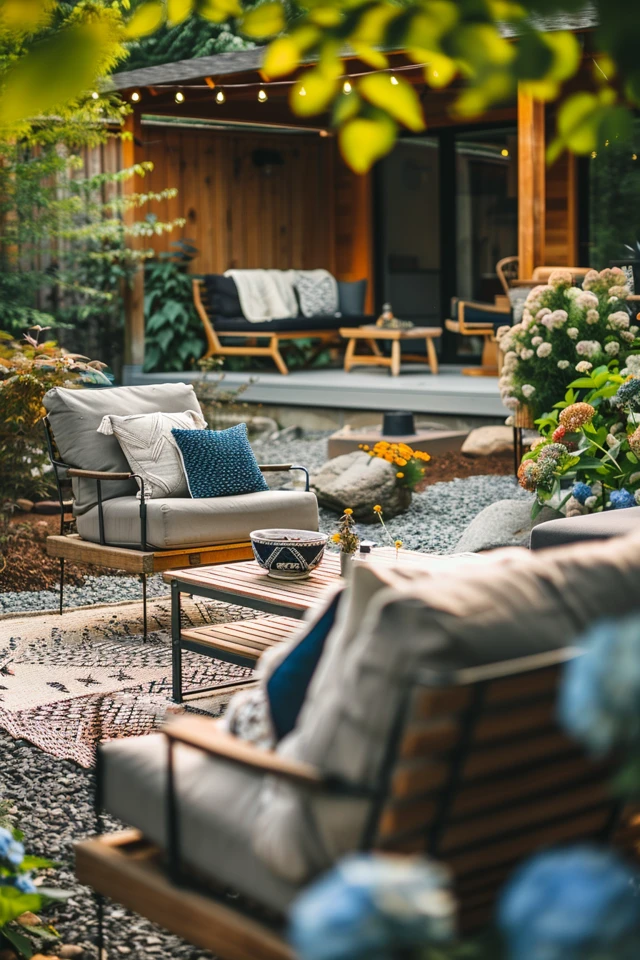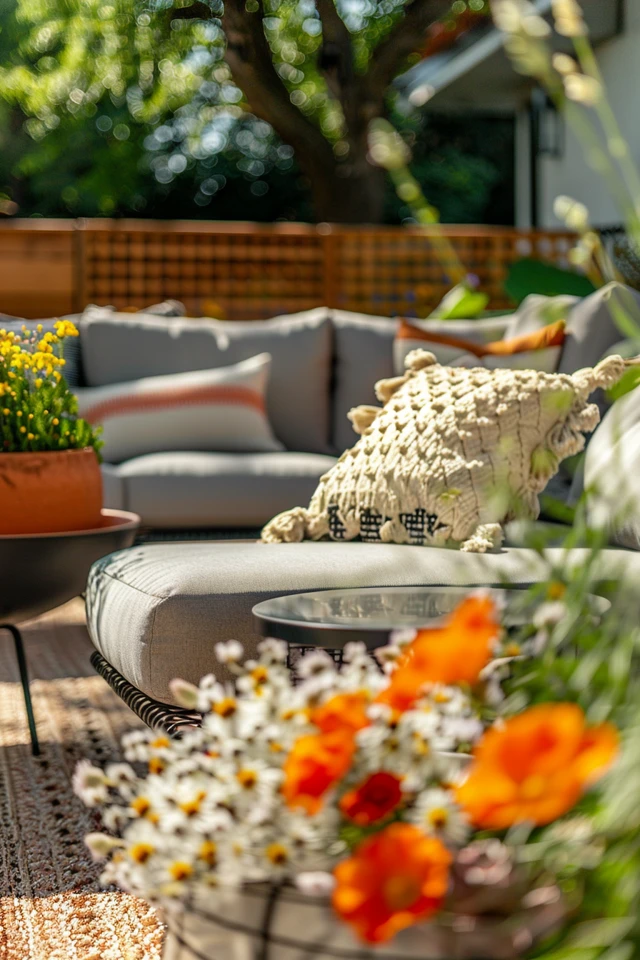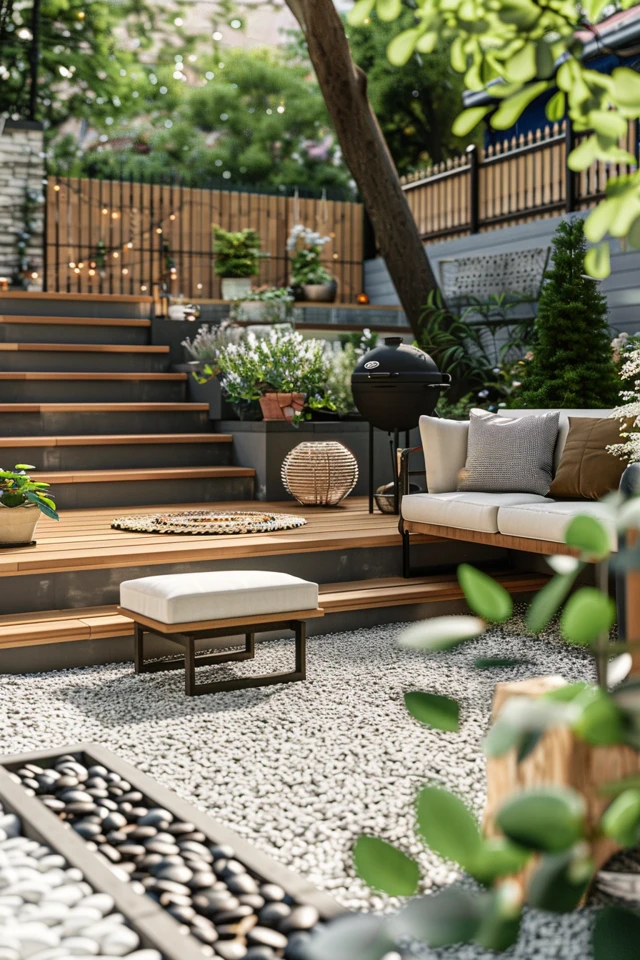As summer approaches, many of us are looking forward to spending more time outdoors and entertaining guests. Having a stylish and functional outdoor space is key to making the most of the season. If you have a multi-level backyard, you have even more opportunities to create an impressive outdoor living area that will leave your guests in awe.
One of the advantages of a split-level backyard is that it can enhance both the functionality and aesthetics of your outdoor space. By incorporating different levels, you can create the illusion of more green space and make your yard appear larger, even if it is on the smaller side.
In terms of design, there are endless possibilities for split-level backyards. You can use various materials, such as black wood, to create steps, planters, and elevated decks that add depth and visual interest to the space. Building different areas on separate levels, like an entertaining space with a firepit and a dining area, allows you to maximize the use of space and cater to different activities.
To create a seamless transition between different areas of your backyard, consider incorporating built-in seating and stone steps. These elements not only serve a functional purpose but also add a touch of elegance to your outdoor space. Additionally, water features can serve as focal points and bring a sense of tranquility to your multi-level backyard design.

Dividing your backyard into sub-areas with different functions can optimize the use of space and make your yard more versatile. By adding greenery to different levels, you can make your yard feel vibrant and inviting. The use of multiple levels in a small yard can create a cozy yet spacious ambiance, providing the perfect setting for relaxing or entertaining guests.
Key Takeaways:
- Multi-level yards can enhance the functionality and aesthetics of outdoor living spaces.
- Incorporating different materials and levels can create a visually appealing backyard design.
- Dividing the backyard into sub-areas with different functions optimizes the use of space.
- Water features and greenery add depth and vibrancy to a multi-level backyard.
- Creating distinct areas in the backyard maximizes the functionality of the space.
Clever Solutions for Split-Level Patios
When it comes to designing a split-level patio, the possibilities are endless. These outdoor spaces offer a perfect balance between creativity and practicality, providing the opportunity to create stunning designs that are both functional and visually appealing. Whether you have a sloping site or a multi-level plot, there are clever solutions that can elevate your patio to the next level.
One of the key advantages of a split-level patio is the ability to showcase different materials, clever planting, and lighting ideas. By connecting different levels in your patio design, you can create a truly unique and impactful space. Consider utilizing contrasting colors, textures, and materials to create a visually stunning palette.
An effective way to add depth and functionality to your split-level patio is by incorporating a raised deck. This feature can serve as a designated area for lounging or create a cozy recessed chill-out zone complete with a fire pit. With a raised deck, you can make the most of your outdoor space and create multiple areas for outdoor entertaining.
To achieve a harmonious and soothing ambiance, it’s important to use a tight palette of materials and tones throughout your patio. This unity of design will create a sense of cohesion and make your patio feel like a seamless extension of your indoor living space.
Adding terraced planters to your multi-level patio not only adds visual interest but also provides space for a variety of functions, such as seating or planting. These tiered planters can create a dynamic and layered look while maximizing the use of space.
Large-scale planters can also play a significant role in connecting different patio levels. By strategically placing these planters, you can visually link the various levels and introduce a third dimension to your design.

For a unique and eye-catching touch, consider using gabions filled with stone. These versatile structures offer both structural support and decorative possibilities, adding a touch of modernity to your split-level patio.
When it comes to highlighting the different levels in your patio design, thoughtful lighting is key. By strategically placing lights, you can accentuate features such as waterfalls or plants and create a magical ambiance in the evening.
Incorporating a second tier to your garden is another way to add visual interest to your patio. This elevated area can serve as a focal point and draw attention to a specific area, such as a seating arrangement or a beautiful garden feature.
A pergola is an excellent addition to a split-level patio. Not only does it provide a sturdy cover, protecting you from the elements, but it also helps define your outdoor living space and creates a cozy atmosphere.
To make a bold statement, consider choosing bold paving or patterned tiles for your split-level patio. These striking features can instantly transform your outdoor space into a work of art.
Adding lighting to steps and raised decking is not only practical but also enhances safety and creates an enchanting atmosphere. Imagine enjoying a summer evening on your patio, illuminated by the soft glow of lights.
Lastly, incorporating different levels and walkways in your patio design can help break up the mass of the space and create visual balance. By integrating creative design details, you can transform your split-level patio into a truly unique and inviting outdoor oasis.
- Split-level patios provide a balance between creativity and practicality
- Sloping sites or multi-level plots offer opportunities for showcasing different materials, clever planting, and lighting ideas
- Connecting different levels in a patio design can result in more impactful color, materials, and planting palettes
- Adding a raised deck to a patio can create a designated area for sun-loving lounging or a recessed chill-out zone with a fire pit
- Using a tight palette of materials and tones throughout the patio can create unity and a soothing ambiance
- Terraced planters can add interest to multi-level patios, while providing space for different functions such as seating or planting
- Large-scale planters can visually link different patio levels and introduce a third dimension to the design
- Gabions filled with stone offer both structural and decorative possibilities for split-level patio ideas
- Thoughtful lighting can accentuate different levels in a patio design and highlight features such as waterfalls or plants
- Adding a second tier to a garden can create visual interest and draw attention to a specific area
- A pergola can provide a sturdy patio cover and create a defined outdoor living space
- Choosing bold paving or patterned tiles can create a striking feature in a split-level patio design
- Adding lighting to steps and raised decking can enhance safety and create an enchanting atmosphere in the evening
- Incorporating different levels and walkways in a patio design can break up the mass of the space and create visual balance

Creating Enviable Outdoor Spaces with Tiered Gardens
Designing a sloping garden can be a challenge, but utilizing split levels can make the space more functional and visually appealing. By cutting steps into steep slopes and combining them with raised flower beds, you can create a stylish and practical design. Incorporating different materials, such as red bricks or outdoor tiles, for hardscaping can add rustic or modern elements to your tiered garden.
Raised decking areas or terraces can help connect your home to the garden and create usable spaces. You can also fill empty voids below raised decks with deep flower beds to add visual interest and make the space appear even. For gentle slopes, consider cutting paths or walkways across the area to create a level walkway and break up the mass of grass.
To maximize the functionality of your tiered garden, consider creating designated zones with split levels. This allows for different areas for dining, a lush lawn, or even water features. Building retaining walls to support level structures can provide opportunities for paved terraces or lawn areas. Adding raised paths using wooden planks can make the sloping area more accessible and visually appealing, while using organic materials like wood and stone can create a rustic finish in your tiered garden design.
Water features can also be incorporated into tiered gardens to add a zen-like atmosphere and accentuate the natural topography of the space. Just remember that designing tiered gardens requires careful planning and professional advice to ensure the structural integrity of the platforms. However, adding multiple levels to a sloping garden can be achieved without the need for full terraces by using raised paths and strategically placed plants. By using natural materials and thoughtful design elements, you can transform your sloping garden into a beautiful and functional space.

